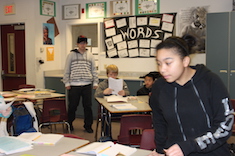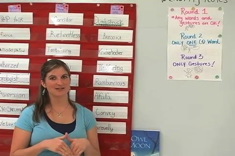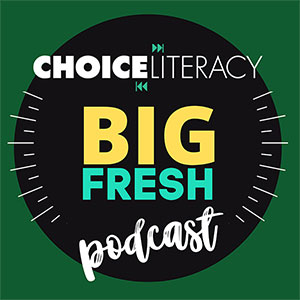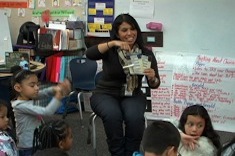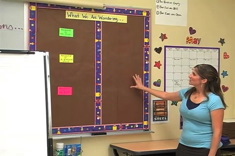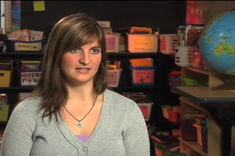“Look! I found eavesdropping in this book.” Aden had placed his book in front of my eyes, completely obscuring my view of my own choice book as he loudly whispered his discovery to me. I set my own choice book down with a smile, and turned my full attention toward Aden.
“Well! Look at that, Aden. How cool that you noticed that.” I peered at him sideways. “Now tell me what it means,” I challenged.
“It means to listen in on someone else’s conversation or something like that.” Aden grinned. I gave him a thumbs-up and a quiet high five, and nodded toward his reading spot, indicating that he should dig back into his book. “Great thinking!” I whispered as he turned away. I love when my students do this.
Noticing words is how we expand our vocabularies in my sixth-grade classroom. Over the years my students and I have determined that arbitrary word lists consisting of random vocabulary words do not enhance our everyday language. Instead, we think hard about the words and language used by the authors we read and respect. We notice unfamiliar words, and we take the time to learn and use them ourselves. Aden was bringing to my attention a word we had studied earlier this year that he was noticing in his choice book. The spontaneity of students interrupting my own reading — or even a reading conference — to let me know they noticed one of our self-chosen vocabulary words is something that is common in my classroom, and I love it. All they need from me is some positive recognition, but it also lets me know that my students are actually thinking about these words and attempting to bring their accurate use into their daily vocabularies. It’s validating for my students to see these new words in other bits of print, and it encourages them to then attempt to use them in their own written and spoken language. After reading time on this day, I will call on Aden to share this bit of knowledge with his classmates. He will read the sentence it was in, and then he will get to choose a peer and ask the same question I asked of him: “What does it mean?”
How We Choose Our Words
Toward the end of class on most days, I spend at least 10 minutes reading from our class read-aloud. This is a novel that we are exploring as a class. Aside from the many short texts we share, this is likely to be the one novel that all of use will be reading at the same time. These read-aloud novels (I typically get through about four a year) are the common texts for our class. This is our source of new language. Every other week or so while I am reading, my students open their reader’s notebooks to the vocabulary section. As they listen to me read the novel, each student takes note of words they are unfamiliar with. As I continue reading and their personal lists grow, I often take a sticky flag and mark a page where there is a word or words I think my students would benefit from learning. At the end of read-aloud time, my students and I share our words as a class. I keep a master list of all the words they share in my own reader’s notebook. We then look at each word closely. Often if I can find it quickly in the text, I will reread the sentence in which the word occurred so we can begin thinking of the context in which it was used. We then go over our word choice criteria. We want to spend our time learning words that will truly enhance our own vocabularies, so we ask ourselves some key questions:
Is it a word that most of us do not know? If only a small handful of the class is unfamiliar with the word, we can do a quick explanation of what the word means, and students who need to write the meaning in their notebooks do so. But we don’t want to spend a lot of word study time on something that will benefit only a few students.
Is it a word that we have heard or encountered before, but whose meaning we’re still unsure of? If so, it is likely somewhat common and well worth learning. Recently we learned the word preposterous. Many students had heard it or thought it sounded familiar, but they couldn’t use it properly or define it. This was a good candidate for a new vocabulary word.
Is the word specific to a narrow area of study — is it simply jargon that we will rarely (if ever) have the opportunity or need to use? If so, we may quickly discuss the definition, but not spend a lot of class time really getting to know the word. A good example is the word alchemy. This word was important in the book we were reading, so we briefly discussed the meaning (and the book did a good job of that too), but we realized it wouldn’t be a word that we would need to use often. A broad understanding would suffice.
With these criteria in mind, I read through each word aloud, and as a class we decide on six or eight that we feel fit the criteria. Because I am reading books aloud that are only slightly challenging for my students (at grade level or just above), there are typically only about eight to ten words within the chapters I read each day that are unfamiliar to them.
Learning Our Words
Our first step to begin learning the words is to go back and study the context. Choosing the words can take some time, so once they are chosen, we typically begin learning them the next day. This gives me time to go back through the text and mark the places in which the word occurred. Then we look at each word, one at a time, and read over the sentences that will help us determine the meaning. As I talk to my students about using context clues, it is important to help them determine which sentences help us learn the meaning and which don’t. We are not going to be able to discern the meaning of a word using context clues all the time. When we do think we know what a word means based on how it is used, we will not always be right. Over time my students begin to realize that sometimes it is the sentences before or after the word even occurs that will help us determine the meaning. Or we find that our schema for the word or events in the book is the most effective tool to help us understand the word’s meaning. Each word becomes the center of a brief discussion that sounds something like the following:
“The word is isolated, class. Let’s read that word together. Ready? Isolated. Raise your hand if you have heard this word before.” There is a smattering of half-raised hands. “Great! Chat for just one minute with your table group about your schema for this word. Where have you heard it? Are there parts of it that sound familiar?” As I look and listen to the chatter, some students genuinely have no experience with this word, and a few have an inkling. They are all thinking hard about it.
“May I have your attention, please? Let me share with you how Patrick Carman used the word isolated in the book Skeleton Creek: “I have a new idea of what someone from the outside might think if they drove into my isolated hometown where it sits alone at the bottom of the mountains.” The word is used as an adjective that describes the town. We take a second to think about that.
“Okay, so we’ve thought about our schema, and the part of speech. Let’s now visualize these few sentences. Carman is describing the town as isolated. It sits alone at the bottom of the mountains. Think about everything you know about Skeleton Creek and bring that knowledge to these two sentences. What clues do we get about what isolated might mean? Discuss in groups. I will call on someone in two minutes.”
As the discussion delves into the meaning of this word, students notice words like alone that help them determine what isolated means. They talk about the fact that Skeleton Creek is a small town seemingly in the middle of nowhere. And after a few minutes of this talk, we determine the meaning of isolated. We double-check in the dictionary just to make sure, and as we read the definition aloud, we always address how definitions can be tricky if we aren’t thinking about how the word is used. Although using dictionaries can be cumbersome, they are useful tools if students know how to use them properly. Looking the word up as a class and discussing the definition options while thinking about the text gives my students practice in how to use dictionaries effectively.
Finally, we write the word and the definition in our notebooks. We also write a new sentence that uses the word correctly so that we can start broadening our use of it. In addition to writing how the word is used, I will often take a minute or two and share the different uses of the word. Isolated the adjective can be changed to a verb simply by writing isolate, for example. All it takes is a minute to jot down various forms of the word, but it completely expands the understanding my students have of each word. Over the course of two days working in 15-20-minute blocks of time, we explore and define each word we have chosen. But the learning doesn’t stop here. The goal is to actually enhance our working vocabularies. So now, we have to use the words.
Making the Words Our Own
I often take about 20 minutes one class period to allow students to create an engaging sentence for each word. This happens shortly after the words have been chosen and defined. After writing our new words on index cards or sentence strips, I pass out one word to each table group (if there are more than six words, some table groups are divided into two smaller groups). The group has to work together to create a “brilliant” sentence that will help us remember the meaning of each word. Each group is given only about three minutes to do this. After the three minutes are up, each table group shares their sentence. As they are shared, I write the sentences on large chart paper, boxing out the vocabulary words and talking quickly about where commas go and what punctuation we use for each sentence. Then I pick the one I like best. I like to make it a silly competition because the kids really get into it. I hem and haw for a few minutes, and then I choose the sentence that is the most creative, engaging, or funny.
“What do we win?!” the winning team always cries as they are cheering and high-fiving.
“Fame and glory,” I reply drily. It is my stock response. The sentences then get sliced into individual strips, and they live on the walls of the classroom for a while.
Before class is over on this day, I will pull Popsicle sticks (each with a student’s name on it) and ask individuals to define a word. I will go through our newest words first, then ask students to define words we have previously worked on. The expectation is that the words are learned and used, not learned and forgotten. This Popsicle stick practice can be used every day if time allows. Sometimes I just pull three names and remind students of three words. It doesn’t have to be lengthy and cumbersome to incorporate regular vocabulary practice into reading and writing workshops.
On other days, I will have my students free-write using our new words or a combination of new and old vocabulary. After 10 minutes of writing time, they share their writing with a friend, and together they need to determine if the words are used accurately with the correct tense and part of speech. While they are doing this, I mosey around and eavesdrop (I just used one of our vocabulary words!) on conversations and offer help where needed. Then I call on several random students to share their writing aloud. If a word is misused in a piece of writing, I quickly explain to the writer and the class how it was misused, and as a class we then determine how to fix it. This may seem like putting kids on the spot or in an uncomfortable position, but we all know we are here to learn together. If we aren’t taking risks and making mistakes, then we aren’t learning all that we could be. My students are very respectful of each other’s learning.
I’m also a big fan of having my students act out the meanings of words. We do this by playing charades or a more in-depth (and lengthy) game called Vocabrity that I created based on a party game. For charades, my students have one or two partners. Each group gets a word, and they have five minutes to create a short skit or action that models the meaning of the word. The rest of the class has to guess the word. It’s a lot of fun, and it offers a memorable clue and reminder of what each word means. As I tell my students, any time I can get them in front of the class entertaining me with embarrassing acting, then it is well worth the time it takes.
Vocabulary games are easy to implement and create. Click here to download an explanation of some of my favorites. They don’t have to take a lot of time, but the key to having kids use the language authentically is to keep the words at the forefront of instruction. Don’t forget about them. Make a big deal about them when you hear someone using a vocabulary word or when they are seen in a text. Make the meanings memorable and the learning of them fun.

